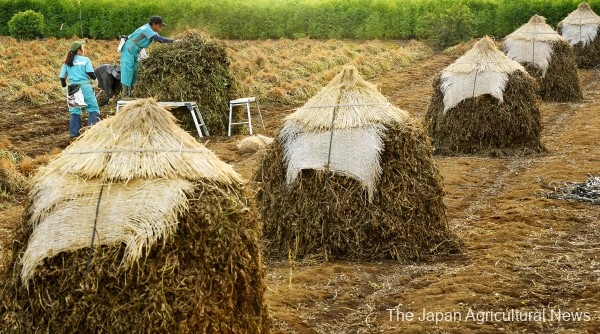Freshly dug peanut plants dried on the fields in Chiba
CHIBA, Oct. 17 – This year’s harvesting and drying of peanuts started in Chiba Prefecture, Japan’s top producer of peanuts.
In the city of Yachimata, a major peanut producing area in Chiba, so-called “bocchi,” heaps of upturned peanut plants, sit on the fields for drying.
Having well-draining volcanic ash soil, Yachimata is suited for cultivation of peanuts which are resistant to dryness.
The cold and dry wind that blows in the region in October helps add sweetness to peanuts.
Production of peanuts is believed to have begun in Yachimata in 1896, as farmers in the area with scarce water resources were looking for items to replace paddy-field rice.
Cultivation area is said to have expanded after dryness-resistant varieties were introduced from China, with peanuts occupying 80 percent of arable land in the area in 1949.
Osamu Furuya, 54, who grows 15 peanut varieties including Chiba Handachi and Q-nuts on a 70-are land, is one of a few farmers who uses the traditional method of drying them.
He harvests crops by cutting the roots with a tractor, ties three or four plants together in a bundle, flips them upside down and dries them for about a week.
Then he piles them up to make bocchi, and the plants are dried for about a month more.
Peanuts harvested at this time of the year need to be dried well since they are used for roasting.
Bocchi is made by piling up the bundled plants in such a way that peanut shells are placed inside the heap.
Each bocchi is about 2 meters high, covered at the top with a mushiro seating mat and a braided hat made of rice straw and hemp cord.
Furuya got disused mushiro mats from a tatami floor mat shop and obtained rice straw from neighboring farmers to make braided hats.
In recent years, more farmers cover the plants with plastic sheets instead of mats and hats or dry them in a tunnel to reduce the burden and costs.
“It’s easier for moisture to escape from above if you use rice straw. Although it takes time and effort, it can’t be helped if you want to make high-quality peanuts,” Furuya said with a smile.

